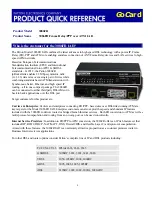
19 Operation on an ISDN Access
216
ARGUS 152
19.4 Bit Error Rate Test
The bit error rate test (BERT = Bit Error Rate Test) is used to check the transmission quality
of the access circuit.
As a rule, the network operator will guarantee an average error rate of 1 x 10
-7
, in other
words in long-term operation 1 bit error in 10 million transmitted bits. A higher bit error rate
will be especially noticeable in transmitting data.
The application program detects the errors in the data blocks transmitted and requests that
the remote partner send them again, which reduces the effective throughput of the ISDN
connection.
In the bit error rate test, the tester establishes an ISDN connection to a remote tester
(end-to-end) or calls itself (self call), sends a standardized (quasi-) random number string
and compares the received data with that which was sent. The individual bit errors are
summed and depending on the test procedure and equipment evaluated in accordance
with the ITU Guideline G.821.
During the test, the ARGUS counts the bit errors and after the test is done it calculates the
bit error rate and other parameters in accordance with ITU-T G.821.
As a rule, the quality of the network operator’s access circuits is quite good. Therefore, no
bit errors should occur in a one-minute test. However, if an error occurs, the test should be
repeated with a measurement time of 15 minutes to achieve higher statistical precision.
The access circuit is heavily distorted, if more than 10 bit errors occur within a test period of
15 minutes.
Contact the network operator or the supplier of the PBX equipment and ask them to test
your access circuit.
When used on an NGN (Next Generation Network), where a packet switched
connection (e.g. IP) can follow a circuit switched network (e.g. ISDN), the
"UDI64k" must be explicitly selected for the BERT. Then the ARGUS will, in
accord with RFC 4040, switch to clear mode, deactivate the echo canceler and
not use a codec.
















































